The Evergreen State...in Black and White
These photographs depict scenes of life in Washington, the Evergreen State, during the past century. They are taken from the extensive collection of historical photographs located in the of the University Libraries.
The University of Washington attracts students from the state, from around the nation, and from around the world. A state-supported institution, it hosts thousands of students from the Evergreen State's towns, cities, suburbs, and rural areas. These historical photographs evoke the varied landscape, communities, and activities that played a part in shaping the way today's state looks and how it works.
Information on copies of historical photographs is available from Special Collections, located in the Allen Library, B level.

Railroad trestles, almost pristine in their newness, cross the salt marshes of Grays Harbor at Hoquiam about 1891. In the center distance is the magnificent new Hoquiam Hotel , built in anticipation that the arrival of the railroad would bring tourists as well as industry. The hotel failed during the depression of the early 1890s, but the unappealing reality of the nearby beach probably contributed to its financial problems. Photographer unknown. Neg. no. UW4389

Steam and smoke mark the Bloedel Donovan sawmill at Skykomish in the early 1920s. A huge jumble of huge logs await their turn. The completion of the Great Northern Railroad in 1893 opened new markets for lumber produced in the Pacific Northwest, and helped create mill towns such as Skykomish. Darius Kinsey photograph #2482. Neg. no. UW572
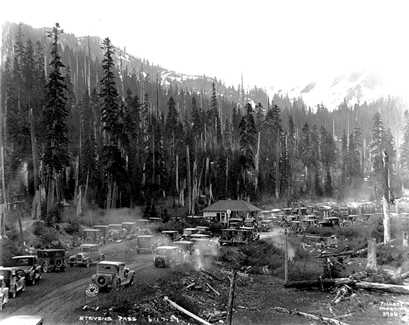
On an early June day in 1927, this is the summit of Stevens Pass: an epic traffic jam. This is not a typical scene: these motorists are part of a group promoting the improvement of state roads. The service station offers Red Crown gasoline. Lee Pickett photograph. Neg. no.3908

The promise of agricultural success is represented by this scene of two gentlemen shaking hands agreeably, while the newly-abundant waters flow. The photo was taken in 1911 to promote land and water rights sales by the Moses Lake Land and Irrigation Company. Asahel Curtis photograph. Neg. no. 21840
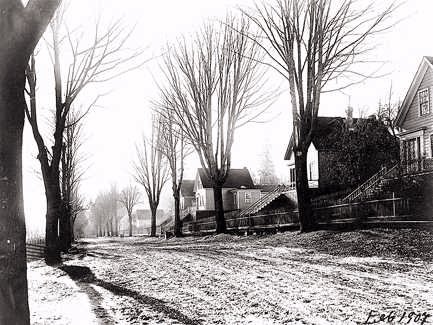
It looks like a village in New England, which was exactly what its builders had in mind. This is Port Gamble, a company town of the Puget Mill Company, as it looked on a bleak Friday, February 26, 1907. Although the streets are now paved, the town looks remarkably similar today. Founded in 1853, Port Gamble was maintained as a company town by successor Pope Resources until 1996, and is listed on the National Register of Historic Places. The street trees are sugar maples, whose seeds were sent out from the East Coast. Photographer unknown. Neg. no. UW4948
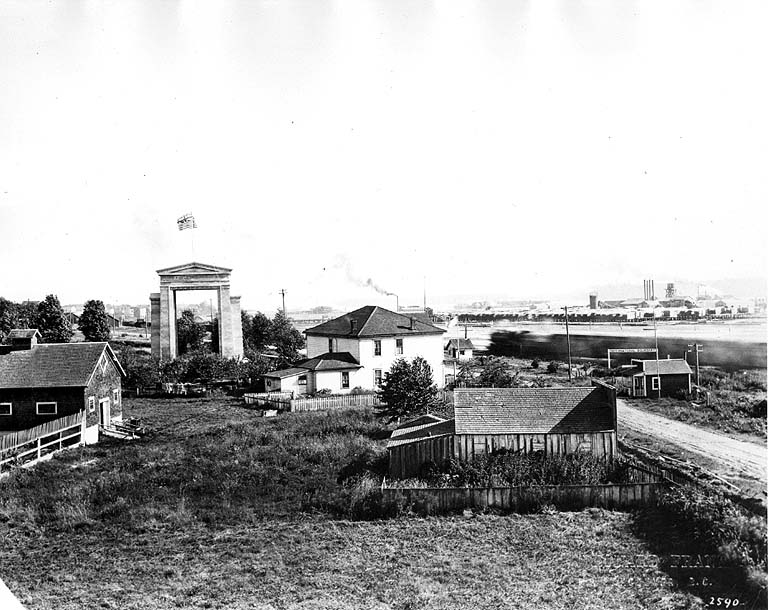
The Peace Arch at Blaine once had a more peaceful setting, as shown in this photograph taken in the 1920s. At the right is the sign marking the international border. A Seattle-bound express train streaks past from Vancouver on the Great Northern Railroad. Leonard Frank photograph. Neg. no. 1638

Literally carved out of the forest, the Bush House hotel is shown shortly after its construction about 1891. It has been enlarged over the years, and is still a prominent landmark in the town of Index, offering food and lodging. Photographer unknown. Neg. no. UW14521
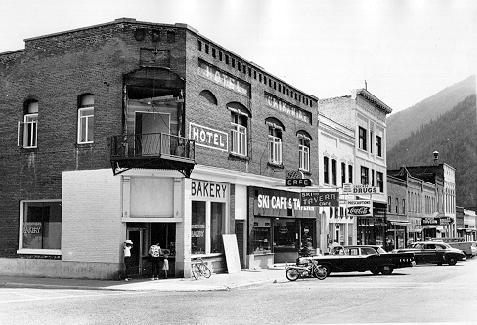
In 1960, Leavenworth was a sleepy mill town with a main street of drug stores, a bakery, and taverns, in two- and three-story brick buildings from the turn of the century. A town rejuvenation effort has now buried these storefronts beneath a jumble of faux Bavarian facades. Photographer unknown. Negative no. UW15492
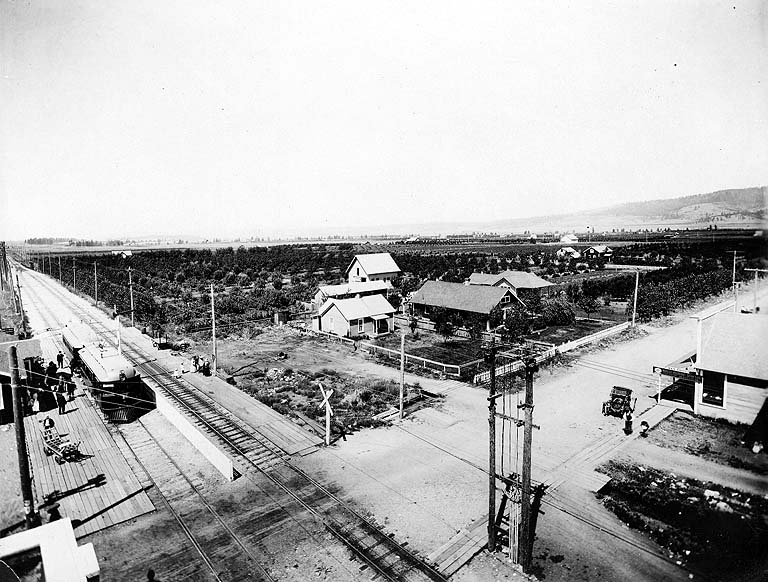
A scene of the suburban ideal, circa 1910. At the left, a two-car interurban train of the Spokane & Inland Empire Railroad drops off passengers and express from the metropolis on its way to Liberty Lake. At the right, a country store advertises dry goods and shoes; out front is an automobile, the first of what will become a horde in a few years. In the center, and along the tracks, are the magical electric lines that run the railroad, light the store and houses, and pump water for the orchards. Photographer unknown. Negative no. UW6323

This was the wedding of Mr. and Mrs. Jens Moe, the first to be held at the New Salem Free Lutheran Church in Silvana about 1900. The photograph was taken by the owner of the town's general store. Iver Botten photograph. Negative no. UW5246.
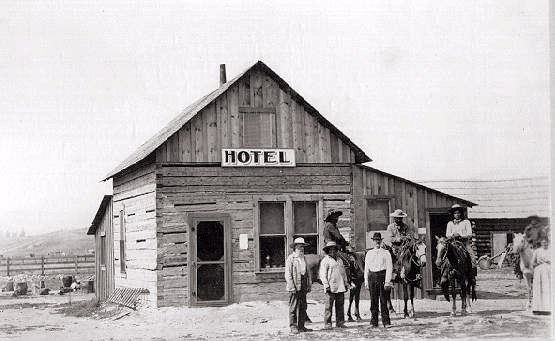
The accommodations may not be elegant, but they are sturdy. The hotel at Nespelem was photographed about 1910 by Dr. Edward H. Latham, resident physician on the Colville Indian Reservation and an expert amateur photographer. Latham photograph. Negative no. UW4852
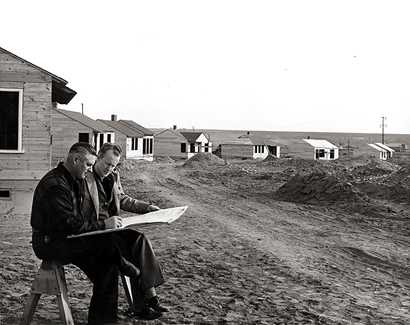
A housing project takes shape near Moses Lake in "a scene typical of much of the Columbia Basin Project irrigation area today, as the delivery of the first gravity irrigation next spring nears." The first water reached the area in 1952. US Bureau of Reclamation photograph. Negative no. UW16760
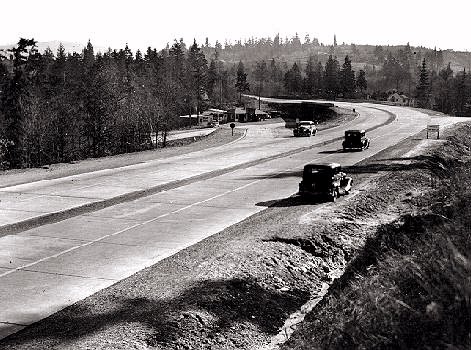
The roads are nearly bare of traffic on the new highway crossing Mercer Island. The completion of the Lake Washington floating bridge east from Seattle in 1940 opened the island to rapid suburban development after the end of World War II in 1945. Asahel Curtis photograph. Negative no. 65460

Citizens of Ilwaco, and military men from nearby Fort Columbia, gather around the body of a large sea lion, "killed May 5, 1896," near the mouth of the Columbia River. Photographer unknown. Negative no. UW 16759

Surrounded by a weathered picket fence, this is the grave of Mary Kitsap at St. Peter's Catholic cemetery in Suquamish, photographed in 1911. Asahel Curtis photograph. Neg. no. 20094

The wheat harvest is underway at the Bush family farm, located near Oak Harbor on Whidbey Island, in a photograph taken in the 1890s. Photographer unknown. Negative no. UW5537

A woman holds the reins on a horse-drawn combine as it works through a wheat field in Spokane County in the early years of the twentieth century. Photographer unknown. Negative no. UW1664
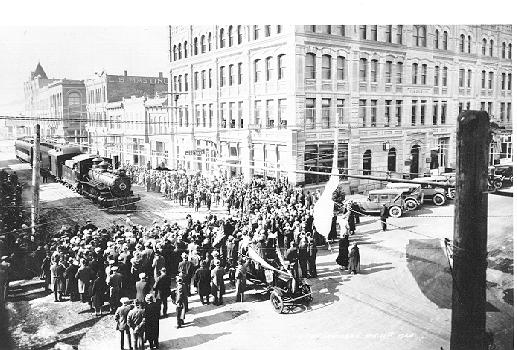
Late morning, Sunday, October 11, 1925: the crowd is celebrating the driving of the golden spike, completing an extension of the Milwaukee Road railroad tracks to the Union Wharf in downtown Port Townsend. That day brought another significant change to transportation to the city and to the Olympic Peninsula, as trains from Port Angeles now connected directly with a new twice-a-day boat to Seattle. The newly remodeled Olympic (formerly the passenger steamer Sioux) could also ferry 45 automobiles. Photographer unknown. Negative no. UW5132

Population in the state of Washington increased rapidly during and after World War II. By 1949, Tacoma, the state’s second-largest city, had about 139,000 residents, but, as the scribblings on the sign suggest, the figure was rising. Howard Clifford photograph. Negative no. UW834
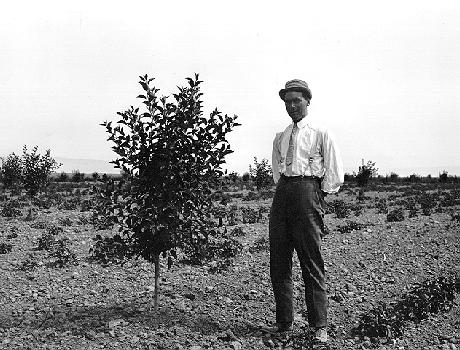
There is unmistakable optimism here, as a young man proudly poses behind an infant tree in a newly planted orchard. The optimism was probably warranted. The spread of irrigation in Yakima County where this picture was taken in the early 1900s, helped to create an immensely successful fruit industry in the State. Photographer unknown. Negative no. UW7040
This Web exhibition copyrighted by the University of Washington Libraries. The exhibition may be used online, parts of it downloaded for personal use, or the URL for the exhibition may be included in another electronic document. For information on reproductions of the images and use guidelines click here or contact Special Collections.



